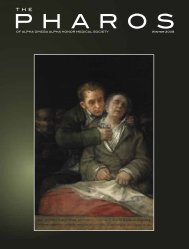Download The Pharos Winter 2011 Edition - Alpha Omega Alpha
Download The Pharos Winter 2011 Edition - Alpha Omega Alpha
Download The Pharos Winter 2011 Edition - Alpha Omega Alpha
Create successful ePaper yourself
Turn your PDF publications into a flip-book with our unique Google optimized e-Paper software.
Charles H. Best.<br />
Courtesy of the National Library of Medicine.<br />
We only have a two cc. syringe you<br />
know and so Blanche [her nurse]<br />
fills that and gives it to me and then<br />
unscrews it from the needle which<br />
is left sticking in to me (I feel like a<br />
pincushion) fills it again, and gives<br />
me that (am left a pincushion once<br />
more), and then have the fifth cc.<br />
It really is quite a process, and altogether<br />
takes about twenty minutes<br />
for the whole performance. 1p155<br />
<strong>The</strong>re is no indication that Elizabeth<br />
Hughes’s diabetes had worsened, nor<br />
that her sensitivity to insulin had decreased.<br />
Since she remained in Toronto<br />
for the first months of treatment, it is<br />
almost certain she received her insulin<br />
from the same source, Connaught<br />
Antitoxin Laboratories. A lack of consistency<br />
in production protocol and<br />
continued efforts to increase their yield<br />
resulted in wide fluctuation<br />
in the final product’s<br />
activity. <strong>The</strong>refore, while<br />
Canadian researchers held<br />
the definition of an insulin<br />
unit constant in terms of<br />
its clinical effects on rabbits,<br />
the actual dosage fluctuated<br />
greatly. 1<br />
An ever-evolving unit<br />
Late in 1922, additional<br />
criticism of the definition<br />
of the insulin unit emerged<br />
from giants in American<br />
diabetology such as Dr.<br />
Frederik Madison Allen<br />
and Dr. Elliot P. Joslin.<br />
<strong>The</strong>se physicians and their<br />
colleagues disliked the<br />
“physiologic unit” of insulin<br />
because its relative<br />
strength in humans forced<br />
some patients to receive<br />
fractions of a unit, creating<br />
confusion among patients<br />
and nurses alike. 4 Clowes<br />
at Lilly brought their<br />
concerns to the IC. On<br />
December 30, 1922, they<br />
announced:<br />
<strong>The</strong> Toronto Committee conferred<br />
with Drs Clowes, Allen and Joslin as<br />
to the adoption of a unit for Insulin<br />
required to lower the blood sugar<br />
and the following conclusions were<br />
arrived at:<br />
1) <strong>The</strong> unit adopted for Insulin<br />
shall be approximately one-fifth that<br />
of the original Toronto unit, which<br />
is the amount of Insulin required to<br />
lower the blood sugar of a 2 kg fed<br />
rabbit 0.045 per cent within four<br />
hours, and cause symptoms. 4<br />
This new unit was to be called the “clinical<br />
unit” of insulin as opposed to the<br />
original “physiological,” “Toronto,” or<br />
“rabbit” unit. In this manner, the IC<br />
had adjusted its calibration of insulin to<br />
accommodate the needs of clinicians,<br />
as represented by Lilly. Further col-<br />
laborations between the pharmaceutical<br />
company and the IC would not proceed<br />
as smoothly.<br />
As with Elizabeth Hughes’s insulin<br />
supply, clinicians in 1923 complained of<br />
potency discrepancies among batches<br />
supposedly of the same clinical strength.<br />
California physician W. D. Sansum and<br />
his research team provided unique insight<br />
into the unit’s evanescence. During<br />
early 1923, they helped establish the<br />
“sugar-metabolizing power” of a given<br />
lot of insulin—the amount of sugar metabolized<br />
by each insulin unit. <strong>The</strong>y<br />
showed Lilly’s insulin to have 1.25 grams<br />
of sugar metabolizing power per unit. 5<br />
Unfortunately, clinicians and their patients<br />
remained vulnerable to continued<br />
unit modifications elsewhere.<br />
Beginning in May, the researchers<br />
noted that previously well-controlled<br />
diabetic patients had sugar reappearing<br />
in their urine. <strong>The</strong> new insulin<br />
units’ sugar metabolizing power had<br />
decreased by approximately one third<br />
compared to one month previously. <strong>The</strong><br />
authors state:<br />
We then learned that the unit had<br />
been redefined as being one-third<br />
of the amount required to lower<br />
the blood sugar below 0.045% and<br />
cause convulsions in a two-kilogram<br />
rabbit which had been previously<br />
starved for twenty-four hours. This<br />
redefinition was based on the belief,<br />
supported by experimental evidence,<br />
that it requires four times as<br />
much insulin to cause a convulsion<br />
in a two kilogram rabbit as in a<br />
one kilogram rabbit. In using onethird<br />
instead of one-fourth the convulsion<br />
[dose] in the two kilogram<br />
rabbits, these workers believed that<br />
they were increasing the value of<br />
the unit. 5<br />
<strong>The</strong>ir comments allude to discrepancies<br />
in rabbit size between Lilly’s laboratories<br />
and those of the IC. While Toronto<br />
had been using two-kilogram fed rabbits<br />
in its tests of potency, Lilly had<br />
been using one-kilogram fasting rabbits.<br />
<strong>The</strong> <strong>Pharos</strong>/<strong>Winter</strong> <strong>2011</strong> 31














